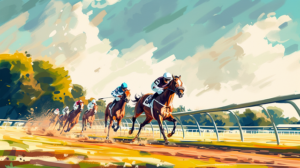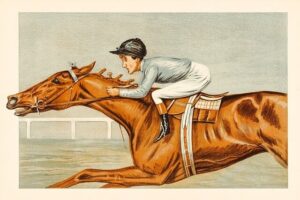 Hayley Turner made headlines late last year, not for the first time in her lengthy, if somewhat interrupted, career by reaching the landmark of 1,000 career winners – 979 of which had been on British soil – at Chelmsford on November 21, 2023. Her milestone victory on Tradesman, in the Illuminate Christmas Ball Handicap, was fitting, insofar as the four-year-old is owned by Khalifa Dasmal and trained by David Simcock, the same connections who provided Turner with her breakthrough Group 1 winner, Dream Ahead in the July Cup at Newmarket, in July 2011. After bringing to an end a month-long losing streak, Turner told Racing TV, ‘It feels like a bit of a relief now. I kind of made a big deal about it and then put pressure on myself. I’ m just chuffed.’ Turner is the first female jockey to win 1000 races.
Hayley Turner made headlines late last year, not for the first time in her lengthy, if somewhat interrupted, career by reaching the landmark of 1,000 career winners – 979 of which had been on British soil – at Chelmsford on November 21, 2023. Her milestone victory on Tradesman, in the Illuminate Christmas Ball Handicap, was fitting, insofar as the four-year-old is owned by Khalifa Dasmal and trained by David Simcock, the same connections who provided Turner with her breakthrough Group 1 winner, Dream Ahead in the July Cup at Newmarket, in July 2011. After bringing to an end a month-long losing streak, Turner told Racing TV, ‘It feels like a bit of a relief now. I kind of made a big deal about it and then put pressure on myself. I’ m just chuffed.’ Turner is the first female jockey to win 1000 races.
Turner, 40, rode her first winner, Generate, trained by Mark Polglase, in an apprentices’ handicap at Pontefract on June 4, 2000. The four-year-old proved to be her only winner from 16 rides in her inaugural season but, under the auspices of Newmarket handler Martin Bell, eventually increased her seasonal tally to nine, 14 and 34 winners in 2002, 2003 and 2004, respectively. Her breakthrough season came in 2005, when she rode 53 winners in the calendar year, surpassing the 75 winners required to ride out her claim and becoming joint champion apprentice, alongside Saleem Golam.
In her third season as a fully-fledged professional, 2008, Turner became the first female jockey to ride 100 winners – in fact, exactly 100 – in a season in Britain. She has yet to exceed that total but, aside from Dream Ahead, has ridden two other Group 1 or Grade 1 winners, namely Margot Did, trained by Bell, in the Nunthorpe Stakes at York in 2011 and I’m A Dreamer, trained by Simcock, in the Beverley D Stakes at Arlington Park, Chicago the following year. In 2015 she swapped saddle for sfoa for a time in joining ITV Racing team , and impartiung her decades of racing knowledge.
Turner has stated that this break was to her advantage. I think people get bored of you,” she stated. “They get sick of hearing ‘Hayley’s done this, Hayley’s done that’. It was nice to step back from that and get out of the bubble. I learned a lot about myself.”
Now in 2024, I think we can safely all say that the break from racing didn’t do Hayley Turner any harm.
 If you enjoy horse racing, whichever code, you may have considered the role of the jockey. You’ve probably praised, cursed and been ambivalent about their performance.
If you enjoy horse racing, whichever code, you may have considered the role of the jockey. You’ve probably praised, cursed and been ambivalent about their performance.